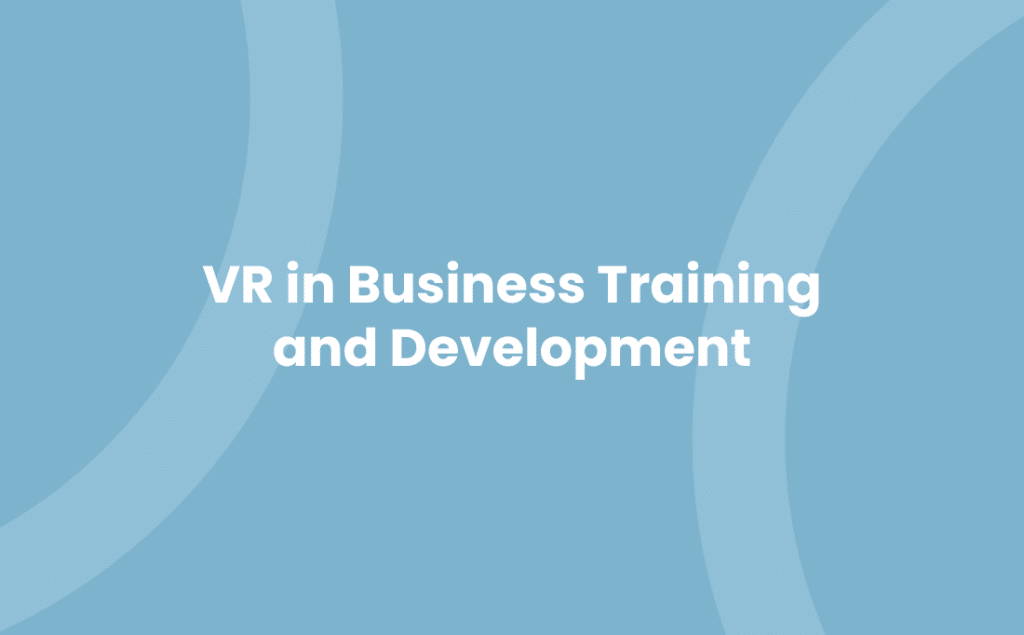Imagine a world where you’re able to train your staff in a risk-free, immersive environment. A world where mistakes are not just allowed, but encouraged for the sake of learning. Welcome to the future of training and development, powered by virtual reality (VR). As part of a broader digital transformation strategy, VR is revolutionising the way businesses train their employees. It’s not just about gaming anymore; it’s about creating real-world experiences that enhance learning and retention. Stay tuned as we delve into the exciting world of VR and its potential to transform your training and development strategy.
Understanding Digital Transformation
Digital Transformation refers to the integration of digital technologies into business operations, altering the way companies function and deliver value to customers. It’s about replacing outdated systems with new, technologically advanced methods. An example of this is the innovative use of Virtual Reality (VR) in training and development strategies.
Digital Transformation is not a one-size-fits-all strategy, with every business needing distinct solutions geared towards its individual needs. In this context, Virtual Reality heralds an exciting chapter in Digital Transformation, providing immersive, real-world experiences in the realm of training and development. For instance, a firm might implement VR programs enabling employees to practise customer interactions in a risk-free virtual space.
The digitalisation of workplaces represents a significant pivot from traditional operational methods. Take the adoption of remote working setups, which the 21st-century business landscape has witnessed in abundance. Here, we observe a blend of factors, such as Cloud computing and collaborative software play a crucial role.
Discussing the VR aspect, digital transformation dives deeper into revolutionising standard procedures. Your company documents, often stored in physical form demanding sizeable space, can transform into Virtual Reality spaces offering an interactive environment. The concept is not confined to data storage; it expands to transforming your training modules from a traditional video or PowerPoints into 3-D interactive sessions.
The beauty of Digital Transformation lies in its adaptability; it’s about making the most of technological advances to suit your business needs specifically. The impact of diligent application of transformative tools like VR isn’t merely highly efficient methods‚ it’s a revolution in the very structure of your business activity. Let’s delve into how VR training can form a part of your broader digital transformation strategy to optimise training and development in your enterprise. So, when you contemplate over Digital Transformation, ponder not only over new technologies but also on investing in your resources. After all, it’s the people that shape the success of your transformation process.
Exploring Virtual Reality (VR)
Dive into the captivating universe of VR, a potent instrument woven into the fabric of digital transmutation. Think about it, in the twinkling of an eye, you’re transported from a conventional setting into a virtually constructed environment. That’s the sheer brilliance of Virtual Reality.
Virtual reality steps beyond mere simulation. It offers you an immersive experience, acquainting participants with situations that hitherto existed only within the realm of imagination. Imagine strapping on a VR headset, you’re instantly part of an unfolding scenario. How’s that for revolutionary!
Fostering a New Learning Experience
The incorporation of VR in your training methodology brings a whole new dynamic. Rather than just reading or hearing about a process, VR training digital transformation facilitates active learning, it’s experiential. It grapples with all your senses, hauling you into a meticulously designed environment, ushering a nuanced understanding that traditional methods generally fall short of.
Visual cues enhance the retention of information. The more engaging the training session, the higher the probability of participants absorbing and retaining the knowledge. This is where VR shines, facilitating an engaging and collaborative atmosphere for learning.
The Future of Training and Development
The escalation of virtual reality development digital transformation in training and development is not a matter of “if” but “when”. Despite initial investment costs, in the long run, virtual reality could contribute to saving resources. Consider situations that require expensive equipment or are risky to recreate. VR fills this void, as trainers can develop these scenarios virtually, efficiently equipping participants for real-world situations without the associated risk or cost.
With the scope for VR in the training arena yet to be fully realised, it’s just the tip of the iceberg. The technology has immense potential to overturn traditional methods, fostering comprehensive learning experiences. Incorporating VR into your digital transformation maximises training effectiveness, forging a path towards the future.
From navigating virtual building walkthroughs in the construction industry to interactive medical procedures for students, VR is steadily becoming an integral component in more and more sectors. It’s not just a possibility, it’s a fast-approaching reality, reshaping the way we view learning and development. So, as a business owner, why not consider the prospect of VR-powered training? The possibilities, you’ll find, are virtually limitless.
Digital Transformation Utilising VR for Training
Progressing further into revolutionary training methods, you’ll observe how integral Virtual Reality (VR) becomes in the digital transformation journey. Working as an immersive tool, VR offers an experiential form of training, an untapped avenue for employee skill development.
First, embrace the fact that VR is a digital revelation for training due to its immersive capabilities. VR offers trainees an opportunity to cultivate crucial skills in a simulated environment. Imagine pilots practising complex manoeuvres, or medical practitioners perfecting surgical procedures, all without any real-world risks.
Second, VR training exhibits exceptional adaptability. From retail sector employees learning customer interaction techniques, to engineers comprehending intricate machine operations, the applicability spans various industries. This adaptability is indicative of VR training’s capacity for widespread knowledge dissemination.
Further, let’s examine VR’s potential for generating vivid, memorable learning experiences. The immersive nature of VR enables learners to partake in interactive simulations, fostering a heightened sense of retention. Unlike passive learning methods, VR promotes a hands-on approach – a solid strategy contributing to effective simulative education.
Then, consider the cost-effective facet of this transformative technology. Implementing VR for training can save resources in the long run. Travelling expenses for in-person training sessions become negligible, while simultaneously allowing businesses to conduct expansive training sessions. What’s more, VR equipment, initially a substantial investment, shows a marked decrease in costs with each passing year, paving the way for affordable, large-scale applications.
Let’s touch upon the accountability VR training brings forth. Digital transformation, by turning to VR, enables real-time tracking and feedback, granting you the capability to gauge trainee progression and understanding. This instant feedback helps course-correct and enhance training effectiveness, a feature that traditional methods often lack.
Seeing this transformative potential, businesses are integrating VR into their digital strategy. VR propels training from theoretical learning to interactive simulations, resulting in skill development that’s unprecedented. This shift makes VR not just a technological advancement, but a notable player in the sphere of employee training and development in the digital age. With Virtual Reality, the future of digital transformation in training truly looks immersive.
Digital Transformation Utilising VR for Development
Let’s delve deeper into the role of Virtual Reality (VR) in digital transformation, primarily focusing on development. The integration of VR facilitates development that’s not just progressive, but also noteworthy due to its active engagement and immersive visual cues.
One monumental advantage of VR for development in a digital transformation context lies in the ability to provide hands-on, real-world simulations. Imagine having your team practising highly specialised tasks in a safe and controlled environment before they venture into actual fieldwork. Now, that’s quite the game changer! Virtual Reality development upskills your staff in their respective roles and brings about improved safety and efficiency metrics.
But, here’s the real clincher. VR complements digital transformation by fostering a high level of adaptability across various sectors. For instance, medical professionals are training in surgical procedures through VR, while seasoned pilots master their skills in flight simulators. The engineering field, too, harnesses VR’s practical, hands-on training approach, bringing about a monumental transformation in their learning and development.
Another compelling conversation starter around VR and digital transformation is the potential for generating vivid, detailed learning experiences that stick. By delivering unforgettable experiences that engage the senses, VR training digital transformation encourages learners to retain and apply their knowledge far more effectively than traditional methods.
Speaking of cost-effectiveness, you’re in for a pleasant surprise. Incorporating VR into your digital transformation strategy may seem like a steep investment at the onset. However, as you reap the benefits of decreased training times, reduced errors, improved recall, and efficient learning, it’s only a matter of time before the return on investment kicks in.
To top it all, there’s a significant accountability factor at play. Virtual Reality in digital transformation not only provides an immersive learning environment but also allows for precise tracking of trainee progress. In other words, you’d be able to gauge employees‚ development and address any gaps proactively with minimal fuss.
To sum up, VR’s immersive, engaging and cost-effective nature makes it an invaluable tool in the digital transformation toolkit. So why not consider a leap into the world of VR for the development of your business? The rewards, after all, are too compelling to ignore.
Balancing Reality and Virtuality: Digital Transformation Challenges
While Virtual Reality (VR) functions as a compelling facilitator for digital transformation in training and development, it’s important to examine its inherent challenges. Virtual and actual experiences inevitably clash, producing a delicate balance businesses need to manage effectively. Pure VR-based training and development might seem like dazzling, cutting-edge tech, but some complexities can make it a formidable task.
First off, the cost of implementing VR may pose concerns for some organisations. Though we’ve noted VR’s long-term cost benefits with reductions in training times and improved information recall, the initial investment can still be hefty. VR hardware, software, and module creation form major components of these initial costs.
Secondly, VR training digital transformation, irrespective of its engaging nature, might induce a sensation known as ‘virtual reality sickness’ or cybersickness, providing a significant challenge. Such unease can distort the immersive training experience, prompting businesses to maintain an optimum balance between reality and virtuality.
Equally important is the challenge concerning adaptability. Not all training scenarios can be successfully replicated in a virtual reality development digital environment. Some skills might require the tangibility of traditional training methods, forcing your organisation to maintains a balance of both.
Lastly, VR lacks the emotional factor, failing to replicate the emotional responses often experienced in real-life scenarios. In professions like healthcare, whilst VR provides practical medical training, it could fall short in preparing individuals for the emotional rigours they might face.
By clearly understanding these challenges, your organisation can strategise and utilise VR to its full potential, paving the way for a successful digital transformation. It’s essential to align VR applications with your business needs and consider potential pitfalls when balancing between reality and the virtual sphere. Remember, selecting the correct mix of traditional and VR training can yield a potent tool for development while still promoting an engaging journey for your workforce.
Future Trends in VR for Training and Development
As businesses strive to maintain pace in an age of digital transformation, a close look at the horizon reveals exciting trends in Virtual Reality (VR) for training and development.
A rise in industry-wide adoption suggests a breakthrough from the niche market status, trailblasing across various sectors. Currently, VR is no longer an experimental tool but an essential component of training initiatives. In industries as far-flung as healthcare and construction, employers use VR in training for high-stakes tasks, with aviation standing out as a pioneering sector‚ a mere hint towards broader future applications.
In line with the second trend, businesses are beginning to comprehend the profound impact VR can have on cognitive learning and soft skill development. Providing immersive learning experiences, VR fosters improved retention rates and accelerates the learning curve, making it a valuable asset in fields demanding significant knowledge transfer, such as medicine and engineering.
Thirdly, with VR’s growing accessibility due to technological advancements and decreasing costs, smaller companies are forecast to utilise this technology, debunking the myth that only large corporations can benefit. Coupled with integrated analytics to track employee progress, VR becomes an invaluable tool offering insights into performance metrics, further driving its popularity in training and development.
Lastly, advancements in VR technology, particularly haptic feedback, elevate its significance. Simulating physical sensations enriches the virtual experience, offering more authentic training scenarios, paramount in industries where precision is critical.
These emerging trends paint a promising picture of VR’s role in digital transformation, urging businesses, regardless of size or industry, to embrace this revolutionary tool. Going forward, VR in training and development is poised to become far more than a fleeting technological fad, standing steadfast among various digital transformation strategies, ready to shape the future.
Conclusion
It’s clear that VR’s role in digital transformation is not to be underestimated. Its potential to revolutionise training and development strategies is immense, offering real-world experiences, active engagement, and adaptability. You’ve seen the challenges it faces, such as high costs and limitations, but also the promising trends that are shaping its future. From industry-wide adoption to advancements in technology like haptic feedback, VR is set to become an indispensable tool for businesses of all sizes. So, it’s time to embrace VR and let it shape your training and development strategies. After all, it’s not just about staying ahead of the curve, but also about equipping your workforce with the skills they need to thrive in a digitally transformed world.


